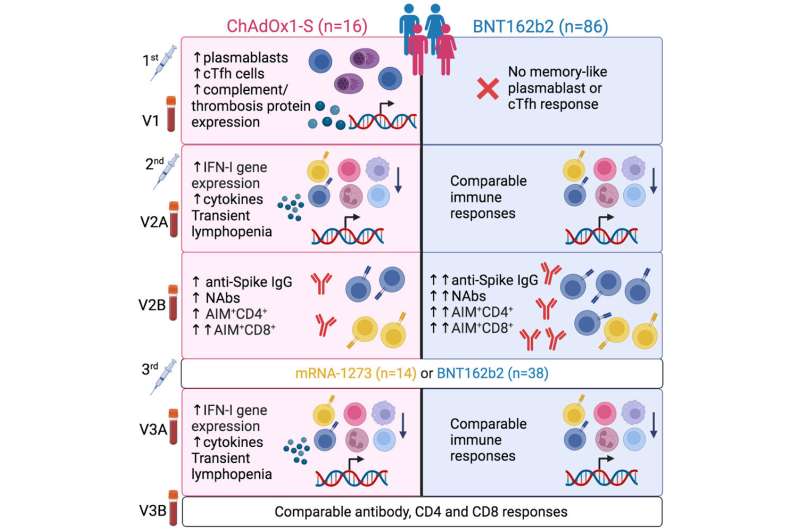A new Australian study led by SAHMRI and Flinders University has uncovered fundamental differences in how the AstraZeneca and Pfizer COVID-19 vaccines impact the immune system.
The COVID-19 Vaccine Immune Responses Study (COVIRS), published in Cell Reports Medicine, tracked the immune responses of 102 adults of varying ages, all living in South Australia where there was no community transmission of SARS-CoV-2 at the time.
Participants had their bloods taken immediately after each dose of either the Oxford/AstraZeneca or Pfizer/BioNTech COVID-19 vaccines to assess early immune response.
They were also tested 28 days after every immunization to evaluate B and T cell activity. Both are critical, as B cells produce antibodies and T cells kill infected cells.
The vaccines are alike in the sense that they induce the immune system to recognize and protect against the SARS-CoV-2 virus, but they differ in how this is achieved.
The Pfizer vaccine uses mRNA technology to induce host cells to produce the SARS-CoV-2 Spike protein, while the AstraZeneca vaccine uses a harmless virus (a chimpanzee adenovirus) to encode the Spike protein.
Head of SAHMRI's Systems Immunology Laboratory and Flinders University Professor David Lynn led the study, using a method of biological analysis known as 'multiomics' to examine immune responses in many different ways in thousands of blood samples.
Professor Lynn says this comprehensive analysis of immune responses to these different vaccines has revealed lots of new information that'll help inform future vaccine design.
"After the first dose, we were surprised to find the Oxford/AstraZeneca vaccine elicits an unexpected memorylike response in the immune system, recognizing the vaccine as if it's something it's seen before," says Professor Lynn, from the College of Medicine and Public Health at Flinders University.
"This response is targeted against the adenovirus vector in the vaccine, not the Spike protein and the intensity of this response correlates with the expression of proteins that act as a pre-cursor to thrombosis, or blood clotting.
"While Vaccine-induced immune thrombotic thrombocytopenia (VITT) is an extremely rare side effect associated with the Oxford/AstraZeneca vaccine that none of the participants developed during the study, this research offers a potential explanation for the connection between the Oxford/AstraZeneca vaccine and the cases of VITT that've been reported."
The study also found those who'd only had two doses of the Oxford/AstraZeneca vaccine generally produced lower amounts of antibodies and less of a specialized type of T-cell that helps with antibody production; compared to those who had two doses of the Pfizer/BioNTech vaccine.
However, this was rectified once they had their third booster dose of an mRNA vaccine, illustrating the importance of booster doses.
The study added evidence to the notion that COVID-19 vaccines offer some people more effective protection than others.
The reasons for this variability are not well understood, but Professor Lynn says age is a factor, with older people generally having a lower immune response after two doses. Fortunately, a third booster dose was highly effective at overcoming this.
Immune responses induced immediately after vaccination predicted the subsequent B and T cell response to the vaccine measured a month later.
"One to two days after initial vaccination we measured gene expression responses in the blood which correlated with adaptive immune responses that mediate protection 28 days later," Professor Lynn says.
A further surprise to researchers was the finding that feeling unwell after a vaccine dose may in fact be linked to its effectiveness.
"People who showed symptoms of fatigue and fever immediately after the third dose were more likely to have better T-cell responses. T-cells play a vital role in vaccine efficacy as they can directly kill viral cells," Professor Lynn said.
The study was a major collaboration involving SAHMRI, Flinders University, Murdoch Children's Research Institute, The University of Melbourne, The University of Adelaide, Basil Hetzel Institute for Translational Health Research, University of New South Wales, The Kirby Institute, Alfred Hospital, Monash University, AstraZeneca and the Royal Adelaide Hospital.
Overall, this project has provided important new insights into the early immune responses to these vaccines and offers a greater understanding of how they work to protect against COVID-19.
- alf9872000
-

 1
1



Recommended Comments
There are no comments to display.
Join the conversation
You can post now and register later. If you have an account, sign in now to post with your account.
Note: Your post will require moderator approval before it will be visible.